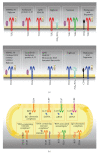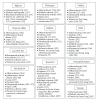DAMPening inflammation by modulating TLR signalling
- PMID: 20706656
- PMCID: PMC2913853
- DOI: 10.1155/2010/672395
DAMPening inflammation by modulating TLR signalling
Abstract
Damage-associated molecular patterns (DAMPs) include endogenous intracellular molecules released by activated or necrotic cells and extracellular matrix (ECM) molecules that are upregulated upon injury or degraded following tissue damage. DAMPs are vital danger signals that alert our immune system to tissue damage upon both infectious and sterile insult. DAMP activation of Toll-like receptors (TLRs) induces inflammatory gene expression to mediate tissue repair. However, DAMPs have also been implicated in diseases where excessive inflammation plays a key role in pathogenesis, including rheumatoid arthritis (RA), cancer, and atherosclerosis. TLR activation by DAMPs may initiate positive feedback loops where increasing tissue damage perpetuates pro-inflammatory responses leading to chronic inflammation. Here we explore the current knowledge about distinct signalling cascades resulting from self TLR activation. We also discuss the involvement of endogenous TLR activators in disease and highlight how specifically targeting DAMPs may yield therapies that do not globally suppress the immune system.
Figures




References
-
- Matzinger P. Tolerance, danger, and the extended family. Annual Review of Immunology. 1994;12:991–1045. - PubMed
-
- Beutler B. Neo-ligands for innate immune receptors and the etiology of sterile inflammatory disease. Immunological Reviews. 2007;220(1):113–128. - PubMed
-
- Bianchi ME. DAMPs, PAMPs and alarmins: all we need to know about danger. Journal of Leukocyte Biology. 2007;81(1):1–5. - PubMed
-
- Gordon S. Pattern recognition receptors: doubling up for the innate immune response. Cell. 2002;111(7):927–930. - PubMed
-
- Medzhitov R, Janeway CA., Jr. Decoding the patterns of self and nonself by the innate immune system. Science. 2002;296(5566):298–300. - PubMed
Publication types
MeSH terms
Substances
Grants and funding
LinkOut - more resources
Full Text Sources
Other Literature Sources

